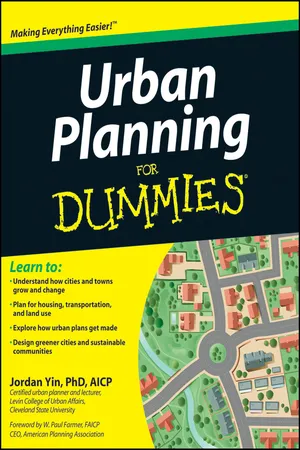Chapter 1
Making Great Cities: Why Planning Matters
In This Chapter
Looking at how cities make and use urban plans
Identifying an urban plan’s main components
Planning for new challenges and great places
Exploring new ideas and ways to improve your community
An urban plan (sometimes called a town plan, master plan, or comprehensive plan) is a guide to the future of a community. Many different kinds of places — from small towns surrounded by farms and countryside to teeming metropolises that are home to millions of people — use urban planning to help sustain and improve their communities.
An urban plan shows what a place could be like in the future. Plans aren’t just about what a place may look like in the future (the shape of its roads, the style of its buildings, or how many trees are in its parks); plans are also used to figure out how a city will function in the future (what kinds of jobs people will have, how much pollution will be created, or what kinds of transportation will move people from one part of the city to another).
This chapter offers an overview of how cities and towns use urban planning to come up with new solutions for their problems. I fill you in on the main components of an urban plan, such as land use, housing, and transportation. I also look at how urban plans get made and who’s involved in making them, and tell you how you can get more involved in planning a great future for your community. All the topics in this chapter are discussed in greater detail in other parts of this book, so you can flip ahead when you come across something that grabs your interest.
The Three Ps: People, Places, and Plans
Urban plans help communities take stock of where they are and where they want to go. Every place is different, and different places change in different ways. Some cities have growing populations; others have declining populations. Some cities rely on subway systems to move people back and forth to work; other cities rely mostly on cars and highways for people to get around.
Urban plans look at current conditions in the community to figure out what’s working well and what may need to be improved. Making a plan is also an opportunity to give members of the community a chance to express what they love about where they live and what kind of place they want it to be in the future.
Planning for changing places
Urban planning looks at what’s good and bad about a community in the present, and plans ahead for how the community can maintain and improve itself in the future. A good understanding of how the community works and how it’s likely to change helps make better plans for the future (see Chapter 2).
Population change
The most general type of population change is whether the size of the population is growing or declining. But the makeup of the population also can change, such as its racial or ethnic composition or changes in the number of young families in the community or the number of senior citizens.
Changing places
The geography of where people live is changing as an increasing number of people live in suburban areas rather than in centrally located urban areas. Many suburban areas are making plans to accommodate larger populations, while many existing urban areas are coping with declining populations and planning for revitalization to attract new residents and retain existing households.
Economic trends
A century ago, most cities were prosperous due to their ability to make things, from clothes and furniture to steel and sausage. In today’s global economy, products can be made anywhere in the world, and successful local economies rely on lots of different types of jobs, including providing services and making products.
New technologies
Whether it’s the continuing influence of the Internet or new ways of using clean energy to power our cities, a wide range of technological innovations will help shape the cities of the future.
Environmental concerns
Cities and towns are increasingly making plans that recognize a wide range of environmental concerns, such as unhealthy air quality and land contamination. Many places also are looking more closely at global environmental conditions and making plans for potential large-scale environmental problems, such as rising sea levels, which could eventually put many coastal cities literally underwater.
Making plans for making places
Most plans for cities and towns are prepared by local government agencies. An official comprehensive plan is the most common type of urban plan. It addresses the long-term future of the community, looks at all the different components of the community (such as housing and transportation), and is officially adopted by the community’s local government.
In addition to long-range comprehensive plans, many communities also have specialized urban plans, such as a strategic revitalization plan for a specific neighborhood that aims for short-term results. A growing number of places also are making plans for metropolitan areas that help coordinate the future development of all the cities and suburbs in that metropolitan region.
In some cases, various government agencies and community organizations are involved in making informal plans for the community. For example, a nonprofit neighborhood association may develop a plan to renovate older housing in its neighborhood and work on establishing partnerships with residents, businesses, investors, and local governments to help carry out the plan (see Chapter 3).
From start to finish, the process of creating an urban plan goes through several steps (see Chapter 4):
...





